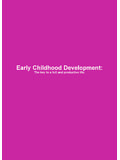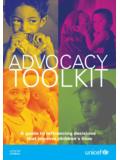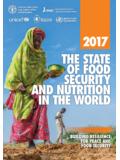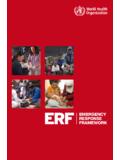Transcription of Formatted 20-SEP-2012 Final UNICEF-WHO-WB …
1 Levels & Trends in unicef -WHO-The world Bank Child Joint Child Malnutrition Estimates Malnutrition This report was prepared at the world health organization and unicef by Mercedes de Onis, David Brown, Monika Bl ssner and Elaine Borghi. Organizations and individuals involved in generating the joint estimates on child malnutrition United Nations Children's Fund Tessa Wardlaw, Holly Newby, David Brown, Xiaodong Cai world health organization Mercedes de Onis, Elaine Borghi, Monika Bl ssner The world Bank Johan Mistiaen, Juan Feng, Masako Hiraga Special thanks go to Dr Francesco Branca, Dr Werner Schultink, and Dr Tessa Wardlaw for their support in the harmonization process and to Mrs Ann Sikanda, Mrs Florence Rusciano and Ms Stacy Young for their assistance in preparing the report. Recommended citation: United Nations Children's Fund, world health organization , The world Bank. unicef - WHO- world Bank Joint Child Malnutrition Estimates. ( unicef , New York; WHO, Geneva; The world Bank, Washington, DC; 2012).
2 WHO Library Cataloguing-in-Publication Data Levels and trends in child malnutrition: unicef -WHO-The world Bank joint child malnutrition estimates. nutrition disorders. nutrition disorders. assessment. status. development. height. weight. I. de Onis, Mercedes. , David. ssner, Monika. , Elaine. health organization . Bank. ISBN 978 92 4 150451 5 (NLM classification: WS 130). _____. The United Nations Children's Fund, the world health organization and the world Bank 2012. All rights reserved. The world health organization and unicef welcome requests for permission to reproduce or translate their publications whether for sale or for noncommercial distribution. Applications and enquiries should be addressed to WHO, Office of Publications, through the WHO web site ( ) or to unicef (Three United Nations Plaza, New York, New York 10017 USA). The designations employed and the presentation of the material in this publication do not imply the expression of any opinion whatsoever on the part of the United Nations Children's Fund ( unicef ), world health organization (WHO) or the world Bank (WB).
3 Concerning the legal status of any country, territory, city or area or of its authorities, or concerning he delimitation of it s frontiers or boundaries. Dotted lines on maps represent approximate border lines for which there may not yet be full agreement. Areas masked in grey correspond to disputed territories and non-self-governing territories. While every effort has been made to maximize the comparability of statistics across countries and over time, users are advise d that country data may differ in terms of data collection methods, population coverage and estimation methods used. Differences between the estimates presented in this report and those in prior and forthcoming publications may arise because of differences in re porting periods or in the availability of data during the production process of each publication and other evidence. All reasonable precautions have been taken by unicef , WHO and the world Bank to verify the information contained in this publication.
4 However, the published material is being distributed without warranty of any kind, either express or implied. The responsibility for the interpretation and use of the material lies with the reader. In no event shall the United Nations Children's Fund, world health organization or world Bank be liable for damages arising from its use. Because of the cession in July 2011 of the Republic of South Sudan by the Republic of the Sudan, and its subsequent admission to the United Nations on 14 July 2011, disaggregated data for the Sudan and South Sudan as separate States were not yet available for this report. Aggregated data presented are for the Sudan precession. Photo credits Cover page: Photo taken in Niamey, Niger. unicef /NYHQ2012-0156/Nyani Quaryme, 2012. Pg 2: Photo taken in Louboutigu village in the Sila Region, Chad. unicef /NYHQ2011-2162/Patricia Esteve, 2011. Pg 3: Photo taken in the Maldives. WHO/Adelheid W. Onyango, 2005. Pg 4: Photo taken in Sholapur District in Maharashtra State.
5 unicef /NYHQ2005-2395/Anita Khemka, 2005. Pg 5: Photo taken in Kibati, Democratic Republic of the Congo. WHO/Christopher Black, 2008. Pg 8: Photo taken in Honiara, Solomon Islands. WHO/Mercedes de Onis, 2010. KEY FACTS AND FIGURES. Stunting Globally, an estimated 165 million children under-five years of age, or 26%, were stunted ( , height-for-age below 2 SD) in 2011 a 35% decrease from an estimated 253 million in 1990. High prevalence levels of stunting among children under-five years of age in Africa (36% in 2011) and Asia (27% in 2011) remain a public health problem, one which often goes unrecognized. More than 90% of the world 's stunted children live in Africa and Asia. Underweight Globally, an estimated 101 million children under-five years of age, or 16%, were underweight ( , weight-for-age below 2SD) in 2011 a 36% decrease from an estimated 159 million in 1990. Although the prevalences of stunting and underweight among children under-five years of age worldwide have decreased since 1990, overall progress is insufficient and millions of children remain at risk.
6 Wasting Globally, an estimated 52 million children under-five years of age, or 8%, were wasted ( , weight-for-height below 2SD) in 2011 a 11% decrease from an estimated 58 million in 1990. Seventy percent of the world 's wasted children live in Asia, most in South-Central Asia. These children are at substantial increased risk of severe acute malnutrition and death. Overweight Globally, an estimated 43 million children under-five years of age, or 7%, were overweight ( , weight-for-height above +2SD) in 2011 a 54% increase from an estimated 28 million in 1990. Increasing trends in child overweight have been noted in most world regions, not only developed countries, where prevalence is highest (15% in 2011). In Africa, the estimated prevalence under-five overweight increased from 4% in 1990 to 7% in 2011. The prevalence of overweight was lower in Asia (5% in 2011) than in Africa, but the number of affected children was higher in Asia (17 million) than in Africa (12 million).
7 Proper nutrition contributes significantly to declines in under-five mortality rates. Improving nutritional status is essential for achieving the Millennium Development Goals (MDGs). Introduction Adequate nutrition is essential in early childhood More recently, during the 2012 world health to ensure healthy growth, proper organ formation Assembly (WHA), a 13-year comprehensive and function, a strong immune system, and implementation plan (2012-2025) to address neurological and cognitive development. Economic maternal, infant and child nutrition was growth and human development require well- The aim of the plan is to alleviate the nourished populations who can learn new skills, double burden of malnutrition in children, starting think critically and contribute to their from the earliest ages. The plan includes six global communities. Child malnutrition impacts cognitive nutrition targets: child stunting, wasting, and function and contributes to poverty through overweight; anaemia in women of reproductive age.
8 Impeding individuals' ability to lead productive low birth weight; and exclusive breastfeeding. lives. In addition, it is estimated that more than one-third of under-five deaths are attributable to In May 2012, the UN Secretary General, declared undernutrition (Liu et al, 2012; Black et al, 2008). the Zero Hunger Challenge (ZHC)3, which initiated powerful, high-level advocacy for a major Nutrition has increasingly been recognized as a advance in global efforts on food and nutrition basic pillar for social and economic development. security. The ZHC aims to encourage different The reduction of infant and young child stakeholders governments, regional malnutrition is essential to the achievement of the organizations, farmers, business, civil society, Millennium Development Goals (MDGs) donors, foundations and the research community particularly those related to the eradication of to join the Secretary General to promote extreme poverty and hunger (MDG 1) and child effective policies, increased investments and survival (MDG 4).
9 Given the effect of early provide sustained development that support childhood nutrition on health and cognitive hunger reduction. development, improving nutrition also impacts MDGs related to universal primary education, At the close of the 2012 Olympic Games, the promotion of gender equality and empowerment of United Kingdom's Prime Minister hosted a summit women, improvements of maternal health and on global child malnutrition, the Global Hunger combating HIV/AIDS. Event, that brought together leaders from the developing world , the private sector and Three years remain to achieve the MDGs. international development agencies to chart a new Nutrition is at the top of the global development course of action aimed at slashing the number of agenda and political commitments to scale up stunted children by 25 million before the 2016. programmes aimed at reducing the scourge of child Olympic Games in Brazil. malnutrition have been made. The Scale Up Nutrition (SUN)1 movement, launched in 2010, calls for intensive efforts to improve global nutrition in the period leading up to 2015.
10 The movement has brought together government authorities from countries with a high burden of malnutrition, and a global coalition of partners committed to working together to mobilize resources, provide technical support, perform high- level advocacy and develop innovative partnerships. 2 See WHA65/A65_R6- 1 See 3 See 1. Essential to the accountability of these global malnutrition dataset to which a unique, peer- movements is monitoring progress towards reviewed, multi-level model is applied in order to agreed upon international targets. produce estimates for various agencies' regional and income groupings. The world Bank joined the Generating accurate estimates of child effort after the annual review meeting in 2012. malnutrition is difficult. Trustworthy estimates One of the most important outcomes to emerge require reliable data collected using recognized from this partnership is the unification of international standards and best practices, estimated prevalence and numbers estimates of employing standardized data collection systems stunting, underweight, wasting and overweight for that enable comparison between countries and over Global and All developing countries'4 averages.














